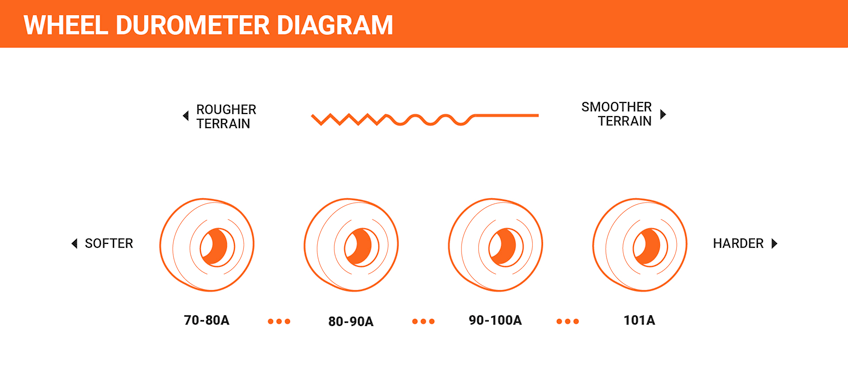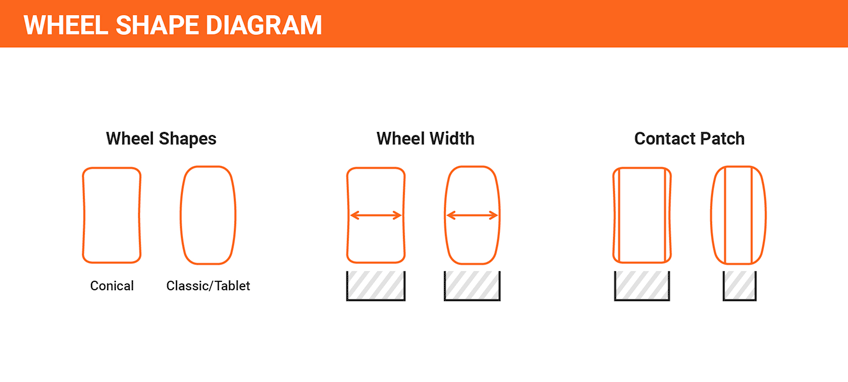In the world of skateboarding, the choice of wheels can make or break your ride. Skateboard wheel durometer, along with factors like diameter and shape, plays a pivotal role in determining the performance and functionality of your skateboard. Understanding these elements is not just essential; it’s the key to unlocking the full potential of your board, as we delve into the history and intricacies of skateboard wheels, exploring why each aspect is paramount for skateboarders seeking the perfect setup.
In this article, we’ll be exploring how the diameter, shape, and durometer (that’s how hard or soft your wheels are) affect your board’s performance, and what you should take into consideration when choosing the wheels that are best for the custom performance you’re looking for.
Wheel Size (Diameter)

Skateboard wheel diameter is a critical factor that profoundly influences a skateboarder’s performance and overall ride experience. The size of your wheel will change how your skateboard performs. Wheel size is measured in millimeters (mm) and refers to the diameter of the wheel. The bigger the number, the bigger the wheel size. Larger wheels will go faster at top speeds, but will accelerate slower, while smaller wheels are slower at top speeds, but accelerate quicker. Larger wheels also raise you and your board higher off the ground, which can affect your maneuvers.
Street skaters typically ride smaller wheels (ranging from 50mm – 56mm) because they allow for good pop, are shaped better for sliding and are lighter for flip tricks, technical tricks, and street skating, where rapid changes in direction are essential. Transition skaters typically ride a slightly larger wheel for higher speeds in the park and better control when riding over coping. Even larger diameter wheels, such as those around 55mm and above, provide a smoother and faster ride as they cover more ground with each revolution. They are excellent for cruising, downhill skating, and maintaining speed through rough terrain.
Choosing the right wheel diameter ensures that your skateboard caters to your specific style of riding and the type of terrain you encounter, ultimately enhancing your control and enjoyment on the board.
Wheel Softness/Hardness (Durometer)

Skateboard wheel durometer is a measurement of the hardness or softness of the urethane material used in skateboard wheels. It is typically measured on a scale ranging from 0 to 100, with higher numbers indicating harder wheels and lower numbers indicating softer ones. Understanding skateboard wheel durometer is crucial for skateboarders because it directly affects the performance and ride characteristics of their boards. Softer wheels (lower durometer) provide more grip and a smoother ride on rough surfaces, making them ideal for street skating and cruising. On the other hand, harder wheels (higher durometer) offer less grip but more speed and slide, making them suitable for tricks, skatepark use, and technical maneuvers. Therefore, knowing the durometer rating helps skateboarders select the right wheels to match their riding style and the type of terrain they intend to skate on, ensuring a safer and more enjoyable experience.
Most wheel manufacturers use the A-Scale for measuring durometer, which is a 100-point scale that indicates how hard or soft the wheel is. Some manufacturers will use a B-Scale which is measured at 20 points lower than the A-Scale. For example, a wheel with a durometer of 80B is the same as a wheel with a durometer of 100A. Depending on the terrain, harder wheels can roll faster and softer wheels may roll slower, but will have more grip. Harder wheels are built for smoother surfaces like smooth streets and skateparks, while softer wheels are better for rougher terrain.
Wheel Durometer Reference Guide
Choose the right skateboard wheel hardness with this handy durometer guide.
| Wheel Hardness | Wheel Type | Recommended For |
|---|---|---|
| 104a / 84b | Harder than hardest – basically rock hard wheels | Typically only seen on Bones/Powerflex wheels |
| 103a / 83b | Extremely hard | Typically only seen on Bones/Powerflex wheels |
| 101a | Traditional very hard street/park wheel | Good for smooth concrete/asphalt surfaces |
| 100a | Hard | Street/park wheel |
| 99a | Medium harder | Street/park wheel, most common street wheel durometer besides 101a |
| 97a | Medium hard | Street/park wheel, better grip than 99+ duro wheels |
| 95a | Medium | Street/park wheel, best for “ditch riding”/semi-rough street/concrete |
| 92a | Medium soft | Street/park wheel, softer wheel considered by Ricta as an “all terrain formula” durometer |
| 90a | Soft street/park wheel | Great for rough streets and concrete – usually lowest durometer offered before being classified as a “cruiser wheel” |
| 87a | Soft street cruiser/filming wheel | Used as OJ’s “keyframe filmer wheels formula” |
| 82a | General cruiser/longboard wheel formula | Good for rougher streets/concrete |
| 80a | Slightly softer cruiser/longboard wheel formula | Handles more rough concrete/asphalt surfaces |
| 78a | Super soft cruiser/longboard wheel | Consider by Ricta as their “cruiser wheel formula” – typically the softest wheels available |
Wheel Shape (Cut)

The shape of skateboard wheels is another crucial factor that significantly impacts your ride. Wheel shape primarily refers to the profile or the cross-sectional contour of the wheel, or the actual width of the wheel from edge to edge. Contact patch refers to the area of the wheel that touches the ground. Wheel shape refers to the cut of the wheel.
Skateboard wheels have two common shapes called classic/tablet and conical. Some companies like Spitfire have more than these two common shapes for a more specific wheel performance. Classic wheels look like a typical skateboard wheel with rounded sides and a beveled edge. The contact patch (riding surface) is generally narrower on a classic skate wheel. Street skaters use classic skate wheels because of the speed they offer, as well as the beveled edge allowing for smooth slides and precise control during technical tricks.
Rather than having rounded sides that stick out, conical wheels have cut out sides which makes the wheel lighter, easier to lock into grinds and roll over coping without as much hang-up. The conical wheel also has a larger contact patch which is slower, but offers more grip and control when skating transitions.
In contrast, cruiser wheels have a square-edged shape that provides more surface contact with the ground, offering better stability and grip. They excel in cruising, commuting, and riding on rough terrain. Choosing the right wheel shape ensures that your skateboard complements your specific riding style and the type of tricks or terrain you prefer, enabling you to maximize your control and performance on the board.
Skateboard Wheels vs. Cruiser Wheels
What makes a cruiser wheel so much different than a street skateboard wheel? In three words, size, shape, and durometer. Typically, cruiser wheels are much softer than skateboard wheels, and usually range in durometer from 76-90A, whereas skateboard wheels usually range in durometer from 91-101A. Cruiser wheels are made for just that: cruising. Some refer to cruiser wheels as “Filmer wheels” since they ride smoother on rough surfaces. The term “Filmer wheels” refers to wheels allowing the quietest possible ride to keep the noise down during shooting. If you want to skate around town with good speed and minimal turbulence, we recommend a cruiser wheel. Skateboard wheels are harder, smaller and lighter which makes popping ollies, learning flip tricks, sliding, grinding and other technical tricks easier.
The Evolution of Skateboard Wheels
The history of skateboard wheels is a fascinating journey that reflects the evolution of skateboarding itself. In the early days of skateboarding during the 1950s and 60s, wheels were primarily made of clay or metal, offering minimal grip and a rough ride. These wheels were a far cry from the smooth, high-performance urethane wheels we have today. The limitations of these early wheels were evident – they provided poor traction, made a harsh noise when riding, and could easily get damaged. However, the sport’s enthusiasts and innovators were undeterred, and in the 1970s, the introduction of polyurethane wheels revolutionized skateboarding. These new wheels, often referred to as “urethane” wheels, offered superior grip, durability, and a smoother ride, paving the way for the modern skateboarding experience. Since then, skateboard wheel technology has continued to advance, with varying durometers, shapes, and sizes to cater to the diverse needs of skateboarders, ensuring that wheels are no longer a limitation but rather an essential tool in pushing the boundaries of what’s possible on a skateboard.
Wheels Are The Foundation of Your Customized Setup
Understanding skateboard wheel durometer, shape, and diameter is paramount for any skateboarder looking to tailor their ride to their unique preferences and the demands of their chosen style. These factors are the building blocks of a customized skateboard setup, each serving a specific purpose in enhancing performance and control.
By grasping the significance of these elements, skateboarders can fine-tune their boards to match their riding goals, ensuring a safer, more enjoyable, and ultimately, a more rewarding experience on four wheels. So, whether you’re cruising the streets, tackling technical tricks, or mastering the art of downhill riding, mastering the nuances of skateboard wheels is the key to unlocking your full potential as a skateboarder. Now that you know what you’re looking for, visit our wheel shop today to get started on the journey to your ultimate ride!



